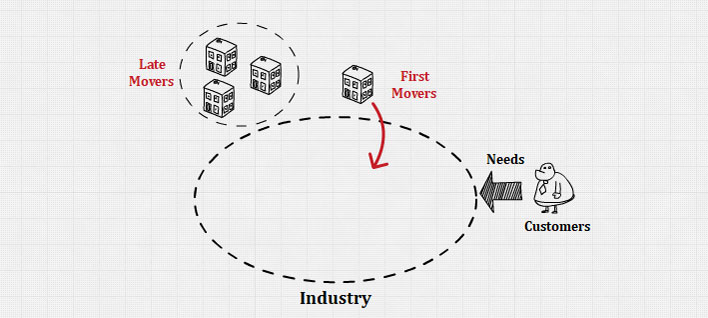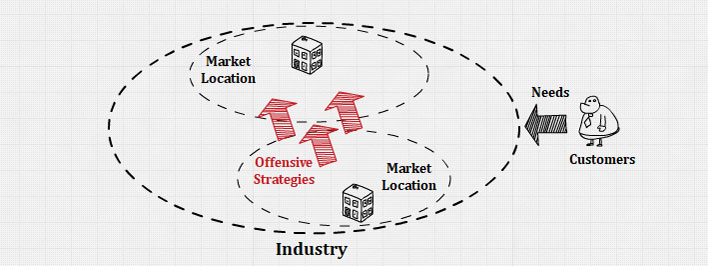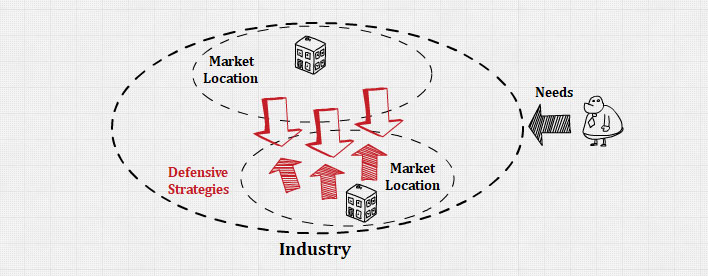A strategic move is a specific plan that details how a strategy can be executed. By their nature, strategic moves are narrower in scope and shorter in time horizon than strategies. Strategic moves, therefore, can be viewed as a link between strategy formulation and strategy implementation.
Some of the strategic moves available to implement strategy and create competitive advantage are strategic timing moves and strategic market location moves.
Strategic Timing Moves

This strategic move deals with when a company executes a strategy. There are 2 types of strategic timing moves, the first mover and the late mover.
Tactic 1: First Mover
First-mover advantages refer to the benefits a firm may achieve by entering a new market or developing a new product or service prior to rival firms.
In general, first-mover advantages tend to be greatest when competitors are roughly the same size and possess similar resources. If competitors are not similar in size, then larger competitors can wait while others make initial investments and mistakes, and then respond with greater effectiveness and resources.
Certain benefits are available to a first mover that will not be available for later entrants.
First-mover advantages are analogous to taking the high ground first, which puts one in an excellent strategic position to launch aggressive campaigns and defend territory.
Being the first mover can be especially wise when such actions (1) build a firm’s image and reputation with buyers, (2) establish a reputation as an industry leader, (3) set standards for all subsequent products in the industry, (4) produce cost advantages over rivals in terms of new technologies, new components, new distribution channels, and so on, (5) create strongly loyal customers, (6) make imitation or duplication by a rival hard or unlikely, (7) gain new knowledge of key factors and issues, (8) carve out market share and a position that is easy to defend and costly for rival firms to overtake, and (9) earn temporarily high profits from buyers.
In general, being the first mover provides great competitive advantages to the firm, but only if the first mover has sufficient resources to exploit the new market and defend its position against later entrants.
Being the first mover also introduces firms to disadvantages and great risks.
The first mover cannot be sure that customers will embrace its offering, thus making a first move becomes inherently risky.
The first mover must also be willing to commit sufficient resources to follow through on their pioneering efforts. The firm bears the costs of developing the product and educating customers. There can be unexpected and unanticipated problems and costs that occur from being the first firm to do business in the new market.
Being the first mover makes firms become a target for others. They may learn from the first mover’s successes and failures, allowing them to cheaply copy or improve the product.
To date, the evidence is mixed regarding whether being a first-mover leads to success.
A first move that builds on strategic resources such as patented technology is difficult for rivals to imitate and thus is likely to succeed.
Perhaps the best question that executives can ask themselves when deciding whether to be a first mover is, how likely is this move to provide my firm with a sustainable competitive advantage?
Tactic 2: Late Mover
Successful late movers tend to be large firms with considerable resources and experience.
Certain benefits are available to a late mover, as follows.
A late mover has advantages of (1) imitating the technological advances of others, (2) keeping risks down by waiting for technological standards and market to be established, (3) advancing rapidly by leapfrogging a first mover’s products with improved second-generation products.
However, late movers often are relegated to replying on the first mover being a slow mover and making strategic or tactical mistakes. This situation does not occur often, so first-mover advantages clearly offset the first-mover disadvantages most of the time.
Strategic Market Location – Offensive Tactics

This strategic move deals with where a company implements a strategy offensively. An offensive strategic move usually takes place in the market location of competitors.
The types of offensive strategic moves are (1) frontal assault, (2) franking maneuver, (3) bypass attack, (4) encirclement, (5) guerrilla warfare, (6) footholds, and (7) blue ocean.
Offensive Move 1: Frontal Assault
A frontal assault is when an attacking firm goes head to head with its competitor. It matches the competitor in every category from price to promotion to the distribution channel.
The attacker must have superior resources and a willingness to persevere. Generally, this is a very costly strategic move.
Offensive Move 2: Franking Maneuver
The franking maneuver is when rather than going straight for the position of strength of the competitors, a firm may attack a part of the market where the competitor is weak.
Offensive Move 3: Bypass Attack
A bypass attack is when rather than directly attacking the strengths and weaknesses of the competitor, the firm chooses to change the rule of the game.
This strategic move attempts to cut the market out from the competitor by offering a new type of product that makes the current product of the competitor become unnecessary.
New types of products can come from a disruptive innovation that can shake up the industry.
Most disruptive innovations are not overnight sensations. Typically, a small group of customers embraces disruptive innovation as early adopters and then a critical mass of customers builds over time.
Firms must ensure that can sustain themselves during an initial period of slow growth.
Offensive Move 4: Encirclement
Encirclement is when the attacking company encircles the competitor in terms of products or markets or both. The encircle generally must have a greater product variety and serves more markets.
Offensive Move 5: Guerrilla Warfare
Guerrilla warfare is when instead of a continual and extensive resource attack on the competitor, a firm may choose to hit and run. These are the intermittent assaults on different market segments held by the competitor.
In this way, the attacker can make gains without seriously threatening large competitors and evoking some form of retaliation. The firm must be patient to accept small gains and avoid pushing competitors to the point that it must respond.
Offensive Move 6: Footholds
In warfare, many armies establish small positions in geographic territories that they have not occupied previously. These footholds provide value in at least two ways.
First, owning a foothold can dissuade other armies from attacking in the region. Second, owning a foothold gives an army a quick-strike capability in a territory if the army needs to expand its reach.
Similarly, some organizations find it valuable to establish footholds in certain markets. Within the context of business, a foothold is a small position that a firm intentionally establishes within a market in which it does not yet compete.
Offensive Move 7: Blue Ocean
A blue ocean move involves creating a new, untapped market rather than competing with rivals in an existing market.
Instead of trying to outmaneuver its competition, a firm using a blue ocean strategy tries to make the competition irrelevant.
Strategic Market Location – Defensive Tactics

This strategic move deals with where a company implements a strategy defensively. A defensive strategic move usually takes place in the current market position of the firm as a defense against possible attacks by rivals.
Executives usually have to decide whether to respond to move made by rivals. Figuring out how to react, or if to react at all, to a competitor’s move is one of the most challenging decisions that firms must make.
Executives in many markets must cope with a rapid-fire barrage of attacks from rivals, such as head-to-head advertising campaigns, price cuts, and attempts to grab key customers. If a firm is going to respond to a competitor’s move, doing so quickly is important. If there is a long delay between an attack and a response, this generally provides the defender with disadvantages.
Research indicates that three factors determine the likelihood that a firm will respond to a competitive move: awareness, motivation, and capability. These three factors together determine the level of competition tension that exists between rivals.
Although examining a firm’s awareness, motivation, and capability is important, the results of a series of moves and countermoves are often difficult to predict and miscalculations can be costly.
Defensive strategic moves aim to lower the probability of attack or lessen the intensity of an attack. This type of move makes the company’s competitive advantage more sustainable to the point of causing competitors to conclude that an attack is unattractive. This type of tactic reduces short-term profitability in ensuring long-term profitability.
The types of defensive strategic moves are (1) raise structural barriers, (2) increase expected retaliation, and (3) lower the inducement for an attack.
Defensive Move 1: Raise Structure Barriers
Raise structural barriers is when the defender attempts to block avenues of the attacker.
Some of the most effective ways are: (1) offering a full line of products in every profitable market segment to close off any entry points, (2) blocking channel access by signing exclusive agreements with distributors, (3) raising buyer switching costs, (4) reducing unit costs by increasing scale economies, (5) limiting outside access to facilities and personnel, and (6) avoiding suppliers that also serve competitors.
Defensive Move 2: Increase Expected Retaliation
Increase expected retaliation is when the defender increases the perceived threat of retaliation for an attack. This counterattack is especially important in markets that are critical to the defending company.
Multipoint competition adds complexity to decisions about whether to respond to a rival’s moves. With multipoint competition, a firm faces the same rival in more than one market.
When a firm has one or more multipoint competitors, executives must realize that a competitive move in a market can have effects not only within that market but also within others.
If rivals are able to establish mutual forbearance, then multipoint competition can help them be successful. Mutual forbearance occurs when rivals do not act aggressively because each recognizes that the other can retaliate in multiple markets.
Defensive Move 3: Lower the Inducement for Attack
Lower the inducement for an attack is when the defender reduces the expectations of the attacker regarding the future profits in the industry.
The defender can deliberately keep prices low and constantly invest in cost-reducing measures. With prices being low, there is little profit incentive for a new entrant.
Defensive Move 4: Fighting Brands
A fighting brand is a lower-end brand that a firm introduces to try to protect the firm’s market share without damaging the firm’s existing brands. The use of fighting brands is a time-tested competitive move.
Firms may lower its price to prevent customers from abandoning them. This can be effective in the short term, but instead, create a long-term problem. Firms will have trouble increasing their prices back to their original level because charging lower prices will devalue the firm’s brand and make customers question why they should accept price increases.
Thus, the creation of a fighting brand can prevent this problem.
Resources
Further Reading
- What Is a First Mover? (investopedia.com)
- First Mover, Late Mover Strategies and Competitive Advantage (mbaknol.com)
- What is the First Mover Advantage? (corporatefinanceinstitute.com)
- The First-Mover Advantage, Explained (blog.hubspot.com)
- First-Mover vs. Late-Mover (brainmass.com)
- The Disadvantages of the Late Mover Theory (sapling.com)
- First Movers Advantage: Benefits, Disadvantages and Examples (indeed.com)
- What Is an Offensive Competitive Strategy? (investopedia.com)
- The Complete Guide to Offensive and Defensive Strategies (drvidyahattangadi.com)
Even More Reading
- Offensive Strategy – Meaning, Types, Examples (marketingtutor.net)
- Differences Between Offensive & Defensive Marketing (yourbusiness.azcentral.com)
- Offensive and Defensive Strategies for Industry Leadership (myventurepad.com)
Related Concepts
References
- Hitt, M. A., Ireland, D. R., & Hoskisson, R. E. (2016). Strategic Management: Concepts: Competitiveness and Globalization (12th ed.). Cengage Learning.
- Hitt, M. A., Ireland, D. R., & Hoskisson, R. E. (2019). Strategic Management: Concepts and Cases: Competitiveness and Globalization (MindTap Course List) (13th ed.). Cengage Learning.